The Maker's 46 Single Cask Experience
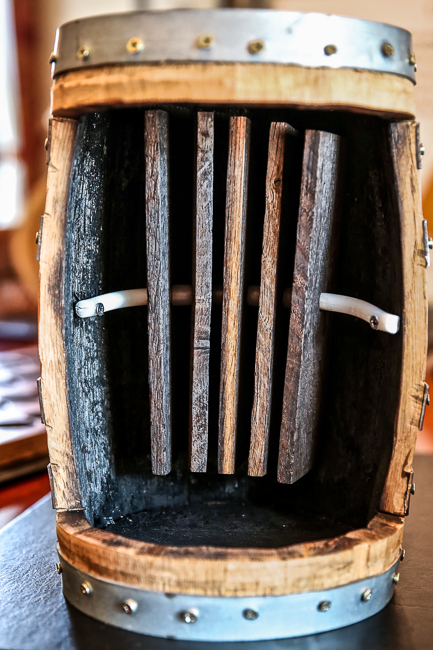
For those of you who have never tasted Maker's 46, the Loretto distillery's only variation on the standard Maker's Mark flavor profile in more than sixty years of operation (not counting the Mint Julep edition), it's a French oak-enhanced formula that stimulates additional spice and richness by the addition of seasoned staves into the barrel during maturation. If you look at the miniature cross-section pictured above, you'll get an idea of what that process looks like. Ten expressive French oak planks are hooked on to a ring and inserted vertically into an empty Bourbon barrel, which is then refilled with mature, cask-strength Maker's Mark and aged for an additional nine weeks. Pretty simple, right? The first time I heard about the idea back in 2010, I can't say I was all that intrigued. It seemed somewhat gimmicky, to be honest, and the idea that three months of additional maturation with a few staves could really make that much of a difference was hard to believe. However, I eventually tasted the 46, realized it was indeed a unique expression of its own with extra spice and richness, and quickly had any doubts or inclinations about the whiskey put to bed. We've happily carried it ever since and it remains popular with our audience. But it wasn't until 2015 that I really understood the potential of the Maker's 46 seasoned-stave process or how far one could take it. I was visiting the distillery on business and my guide that day happened to have a sample of a Maker's 46 variation they had been working on at full proof. "Would you like to taste it?" he asked with a grin. I nodded, tasted, and rejoiced. The increased complexity in the whiskey was equally as drastic as the gulf that exists between the standard Maker's Mark and the cask strength edition—one of my personal favorites. "We're hoping to do a barrel program with this concept in the future," he continued. "Retailers like yourself can come out, pick your own staves, and make your own formula."
"And bottle it at cask strength?" I asked, wide-eyed and rabid.
"Of course."
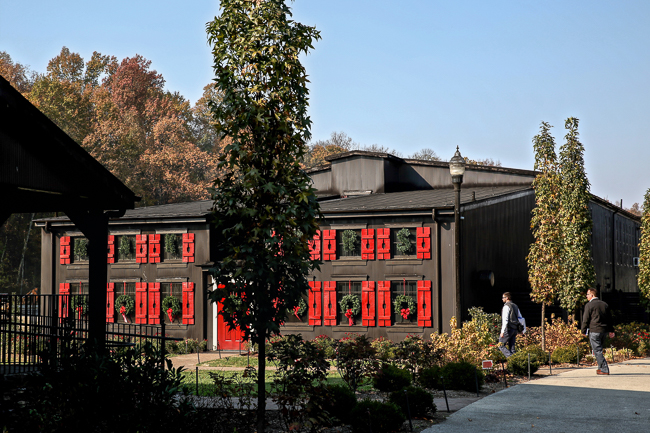
A year later, I was back at Maker's Mark, ready to finally participate in the program I had been eagerly anticipating. It was finally happening. I flew out to Louisville with my Beam-Suntory rep Glen and we met up with Scott Mooney, who has been appointed to oversee the program. The chilly morning weather had my senses crisp and clear. As we walked through the campus towards the old Samuels house the wreathes were adorned on each window, the holiday spirit was in the air, and the mood was perfect for whiskey tasting. Maker's Mark might be my favorite distillery site in the world because of its quaint and rustic charm. There are few places more picturesque and idealistic in the booze business. In no way does it feel like a big distillery. When you come here, you're quickly transported into the Kentucky Bourbon frame of mind.
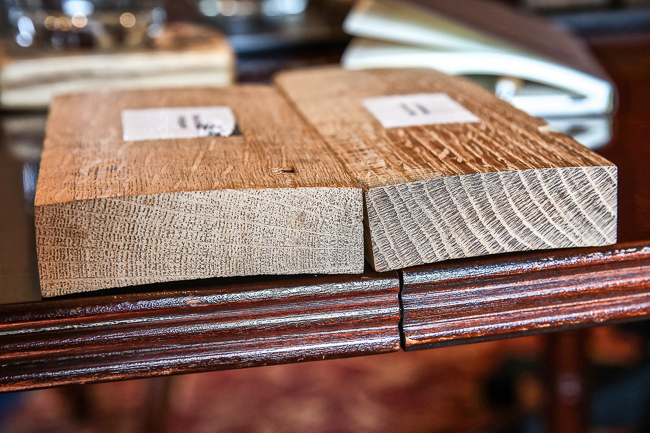
While most whiskey drinkers understand that Bourbon must be aged in new, charred American oak barrels, I'm not sure how many of them know the differences between French and American oak, especially as it pertains to flavor. One thing I never knew until today's visit was the actual reason the whiskey was named "Maker's 46" in the first place. It turns out "46" was the nickname given to the project by the coopers in charge of seasoning the French oak staves due to the latitude of the forest in France where the wood was being sourced. While whiskey drinkers may geek out about fermentation times and distillation times, coopers apparently geek out about the way different types of trees grow in different parts of the world. It turns out that French oak trees grow at a much slower rate than American oak trees do, which in turn creates a tighter growth ring pattern inside the wood itself (as you can clearly see in the photo above) which changes the way the oak influences the whiskey. Part of this phenomenon has to do with the soil and the weather conditions, but it's also an intentional effect. The French government carefully manages the growth of its oak trees (the renowned L'Office National des Forêts) for the purpose of creating tall, straight, and tightly-grained staves that are perfect for cooperage. When seasoned and toasted, French oak has a much more exotic profile than American oak. Wine drinkers know this well as French oak is the preferred vessel for richer cabernet and chardonnay expressions. The official story is that Bill Samuels Jr. was looking to create something "yummy" when he set out to create the "46." The influence of French oak is a great place to start when looking to enhance the richness and spice of any liquid. It often imparts flavors of chocolate, incense, mocha, and nutmeg—all flavors that go well with Bourbon, in my opinion.
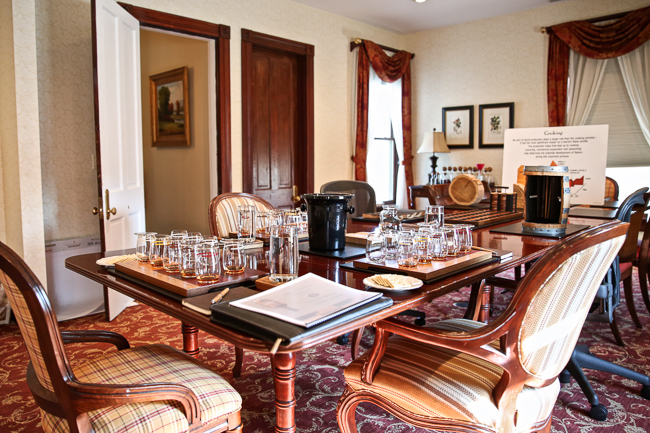
But while Mr. Samuels eventually came across the particularly-perfect French oak stave to create his dream whiskey and satiate his desire, the new Maker's 46 barrel program takes that initial idea and adds four extra possibilities. In addition to the standard Samuels selection, retailers like me can choose from seasoned American oak staves, and two additional French oak recipes: one that imparts heavy mocha and the other more dark cocoa and spice. With ten staves to work with and five different styles to choose from, there are many possible permutations for creating a recipe. But again that's only if you honestly believe the addition of a few staves over the course of nine weeks makes that big of a difference in a whiskey's flavor. To quickly squash any doubt or uncertainty about the efficacy of the process, Scott walked us into an upstairs conference room where he had laid out five individual whiskies, each matured with one individual type of stave for nine weeks. I nosed and tasted all five. They were all completely different, so much so that they could have been made by five completely different distilleries. There was no question about their unique characters. The goal was simply to figure out which flavors I liked and which flavors I didn't in order to create my own version of Maker's 46. After testing the idea out over the course of a year, the folks at the distillery discovered that by blending a test sample of the individual whiskies to the same proportion of staves used in the barrel, they could accurately predict the resulting flavor. For example: a blend of equal parts of all five samples would taste more or less the same as a barrel that used exactly two of each stave. It was up to me to create a blend that suited my fancy. Once I did that, I would know which formula to use for my barrel.
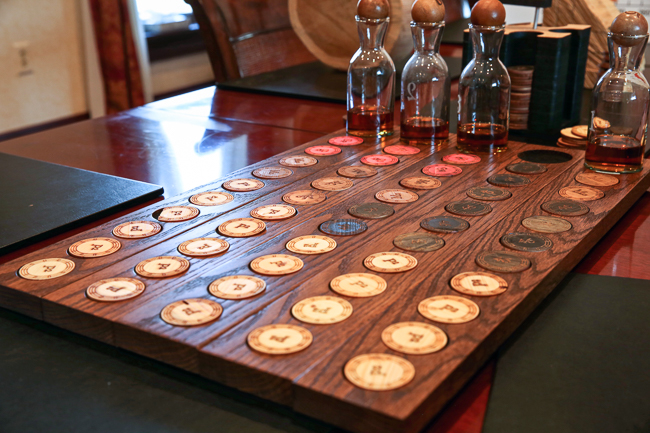
For the purposes of simplifying the concept and streamlining the process, Maker's created poker chips and slotted staves to help track and evaluate each potential formula. You, the creator, get to choose the style and number of each particular stave by choosing the appropriate quantity of chips and Scott, the blender, whips up a test batch of each particular recipe based on each board. Before beginning, however, Scott asked me about my vision. "Well," I began, "I don't want to create some Frankensteinian version of Maker's Mark that no longer tastes like Maker's Mark. I want to keep the core elements intact."
He nodded and jotted down a few notes.
"This is a wheated Bourbon. I want it to still taste like a wheated Bourbon because that's what I like about it. Maybe we can somehow accentuate the sweetness; make it pop somehow in a way it didn't before. That would be nice."
When Bill Samuels set out to create the original Maker's Mark, he wanted the sweetest, most front palate-loaded Bourbon possible. That's part of the reason he eventually chose a wheated recipe, opting for 16% winter wheat in place of rye as the flavor grain in the mash bill. He also dialed up the malted barley to 14% for extra creaminess. On top of that, he had the distillery season its barrels for nine months to a year before using them. What does "seasoning" wood actually mean? Basically, you leave the wood outside and let nature take its course. Through exposure to the elements, the wood begins to breakdown and dry out. During that process the natural tannins in the wood will soften, which is why Bill wanted his barrels seasoned for an extended period. He didn't want wood tannins harshening his mellow, sweet, creamy wheated Bourbon. You know those bold, drying, astringent, and bitter notes you sometimes get in a real woody Bourbon? That's the wood tannins doing a number on your taste buds. Maker's Mark doesn't have any of that tannic character because they use heavily-seasoned casks. At the same time, however, their single casks have less variance as a result. "Part of the reason we didn't just do a Maker's Mark single barrel program is because most of the barrels taste exactly the same," Scott said. "Our whiskey is so carefully matured and well-managed, we realized there wouldn't be much of an incentive to pick one cask over another."
Hence, the creation of a Maker's 46 single cask experience where you can create your own particular variance based on your own particular taste.
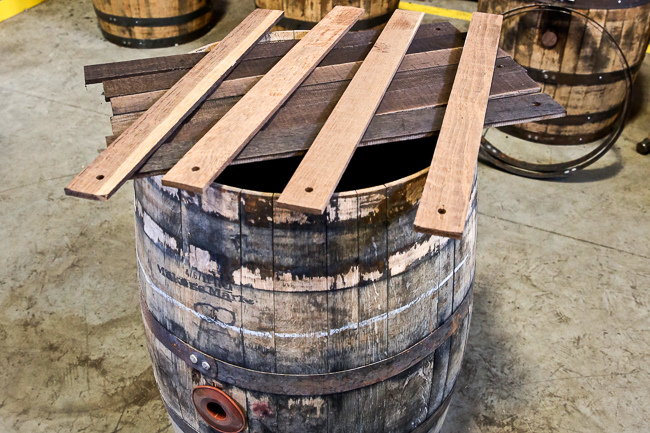
How did I do? Really well, I think! I had a plan—a goal in mind—and a good idea of what would get me there, so I didn't need too much time in the blending room. Scott actually goofed up on my fourth try and inadvertently created the final recipe after mistaking two of the poker chips for the wrong stave. For some reason there were a few chips that were the same color as one another and I used those chips by mistake. Scott misread the formula and didn't catch the problem until it was too late. We soon realized, however, that the error was ultimately our success! The whiskey had everything I wanted: big creamy vanilla flavors, big baking spices, and a big, sweet, wheated Bourbon finish that never wandered over to the dark side. If you've ever wondered why people love Pappy Van Winkle so much, there are two main reasons: it's big and it's sweet. That's what wheated Bourbon is supposed to taste like, that's what I like about it, and that's what I wanted to make today during my Maker's 46 experience. After selecting my staves, filling my barrel, and rolling it into the rickhouse, I called it a day.
Let's cross our fingers and hope our K&L cask tastes as good as the sample blend! We'll find out next Spring.
-David Driscoll
